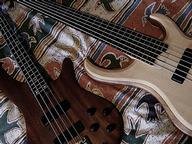
The Low-Down on the Best Bassists! Quiz
On July 1, 2020, "Rolling Stone" published a list of "The 50 Greatest Bassists of All Time". The list was not published based on the artists' skill or genre, but on their overall impact and contribution to the creation of music.
A collection quiz
by ponycargirl.
Estimated time: 3 mins.
- Home
- »
- Quizzes
- »
- Music Trivia
- »
- Guitarists
- »
- Bass Guitarists